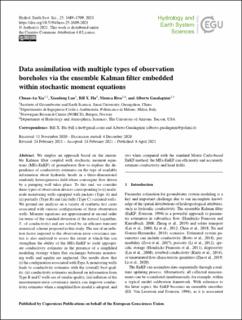| dc.contributor.author | Xia, Chuan-An | |
| dc.contributor.author | Luo, Xiaodong | |
| dc.contributor.author | Hu, Bill X. | |
| dc.contributor.author | Riva, Monica | |
| dc.contributor.author | Guadagnini, Alberto | |
| dc.date.accessioned | 2021-10-28T07:42:06Z | |
| dc.date.available | 2021-10-28T07:42:06Z | |
| dc.date.created | 2021-09-07T15:14:31Z | |
| dc.date.issued | 2021 | |
| dc.identifier.citation | Hydrology and Earth System Sciences. 2021, 25 (4), 1689-1709. | en_US |
| dc.identifier.issn | 1027-5606 | |
| dc.identifier.uri | https://hdl.handle.net/11250/2826162 | |
| dc.description.abstract | We employ an approach based on the ensemble Kalman filter coupled with stochastic moment equations (MEs-EnKF) of groundwater flow to explore the dependence of conductivity estimates on the type of available information about hydraulic heads in a three-dimensional randomly heterogeneous field where convergent flow driven by a pumping well takes place. To this end, we consider three types of observation devices corresponding to (i) multi-node monitoring wells equipped with packers (Type A) and (ii) partially (Type B) and (iii) fully (Type C) screened wells. We ground our analysis on a variety of synthetic test cases associated with various configurations of these observation wells. Moment equations are approximated at second order (in terms of the standard deviation of the natural logarithm, Y, of conductivity) and are solved by an efficient transient numerical scheme proposed in this study. The use of an inflation factor imposed to the observation error covariance matrix is also analyzed to assess the extent at which this can strengthen the ability of the MEs-EnKF to yield appropriate conductivity estimates in the presence of a simplified modeling strategy where flux exchanges between monitoring wells and aquifer are neglected. Our results show that (i) the configuration associated with Type A monitoring wells leads to conductivity estimates with the (overall) best quality, (ii) conductivity estimates anchored on information from Type B and C wells are of similar quality, (iii) inflation of the measurement-error covariance matrix can improve conductivity estimates when a simplified flow model is adopted, and (iv) when compared with the standard Monte Carlo-based EnKF method, the MEs-EnKF can efficiently and accurately estimate conductivity and head fields. | |
| dc.language.iso | eng | en_US |
| dc.rights | Navngivelse 4.0 Internasjonal | * |
| dc.rights.uri | http://creativecommons.org/licenses/by/4.0/deed.no | * |
| dc.title | Data assimilation with multiple types of observation boreholes via the ensemble Kalman filter embedded within stochastic moment equations | en_US |
| dc.type | Peer reviewed | en_US |
| dc.type | Journal article | en_US |
| dc.rights.holder | Copyright © 2021, Authors | |
| dc.description.version | publishedVersion | |
| cristin.ispublished | true | |
| cristin.fulltext | original | |
| cristin.qualitycode | 2 | |
| dc.identifier.doi | 10.5194/hess-25-1689-2021 | |
| dc.identifier.cristin | 1932126 | |
| dc.source.journal | Hydrology and Earth System Sciences | en_US |
| dc.source.volume | 25 | en_US |
| dc.source.issue | 4 | en_US |
| dc.source.pagenumber | 1689-1709 | en_US |

